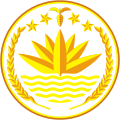| This article is part of a series on the |
| Politics of the People's Republic of Bangladesh |
|---|
 |
|
|
|
|
| Part of a series on |
| Socialism |
|---|
 |

Socialism (Bengali: সমাজতন্ত্র) is one of the fundamental principles of the Constitution of Bangladesh, along with nationalism, democracy and secularism.[1] The constitution names Bangladesh as a people's republic,[2] and declares all powers to be vested to the people.[3] However, in Bangladesh, as a liberal democracy, the reference of "socialism" is generally used to describe the state's goal to construct an exploitation-free society,[4][5] rather than its original meaning and implementation, which is characterised by social ownership of the means of production, as opposed to private ownership. The constitution allows cooperative and private ownership along with state ownership.[6][7]
Socialist and democratic socialist political parties played a key role the independence movement of both British India and Bangladesh. Upon the independence in 1971, country's founding leaders shaped the economy of Bangladesh as a socialist economy as described in the constitution, however, liberal democracy wasn't scrapped. But due to economic mismanagement and political turmoil, the economic system resulted in a stagnation, with the deadly famine of 1974 further created a humanitarian crisis. In 1975, the country's political structure was reorganised in a one-party socialist republic with BAKSAL being the sole legitimate political party. After the 15 August 1975 Bangladesh coup d'état and 1982 Bangladesh coup d'état, reformist military leaders would redefine socialism with social justice in 1979 and eventually introduce market and property reforms to push to a capitalist system. In 2011, the term "socialism" and "socialist" were again redefined to make the constitution more in line with the original document,[8] but the country remained a liberal mixed economy.
- ^ "The Constitution: 8.Fundamental principles". Legislative and Parliamentary Affairs Division Ministry of Law, Justice and Parliamentary Affairs. Retrieved 25 April 2017.
- ^ "The Constitution: 7.Supremacy of the constitution". Legislative and Parliamentary Affairs Division Ministry of Law, Justice and Parliamentary Affairs. Retrieved 25 April 2017.
- ^ "Article 1 of the Constitution of Bangladesh". Legislative and Parliamentary Affairs Division, Ministry of Law, Justice and Parliamentary Affairs. Retrieved 28 June 2021.
- ^ "The Constitution: 10. Socialism and freedom from exploitation". Legislative and Parliamentary Affairs Division Ministry of Law, Justice and Parliamentary Affairs. Retrieved 25 April 2017.
- ^ Phillips, Douglas A.; Gritzner, Charles F. (2007). Bangladesh. Infobase Publishing. p. 65. ISBN 978-1-4381-0485-0.
- ^ Afzalur Rashid, Sudhir C. Lodh (1 January 2008). "The influence of ownership structures and board practices on corporate social disclosures in Bangladesh". Corporate Governance in Less Developed and Emerging Economies. Research in Accounting in Emerging Economies. 8. Emerald Group Publishing Limited: 211–237. doi:10.1016/s1479-3563(08)08008-0. ISBN 9781848552524.
- ^ International Monetary Fund (25 June 2003). Bangladesh: Report on Observance of Standards and Codes-Fiscal Transparency. International Monetary Fund. p. 8. ISBN 9781451877182.
- ^ Cite error: The named reference
GRwas invoked but never defined (see the help page).
© MMXXIII Rich X Search. We shall prevail. All rights reserved. Rich X Search



